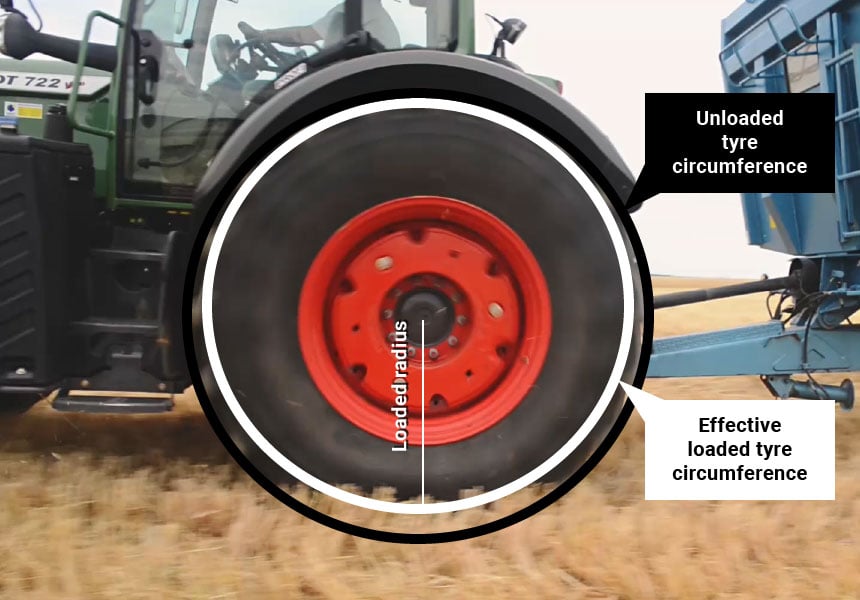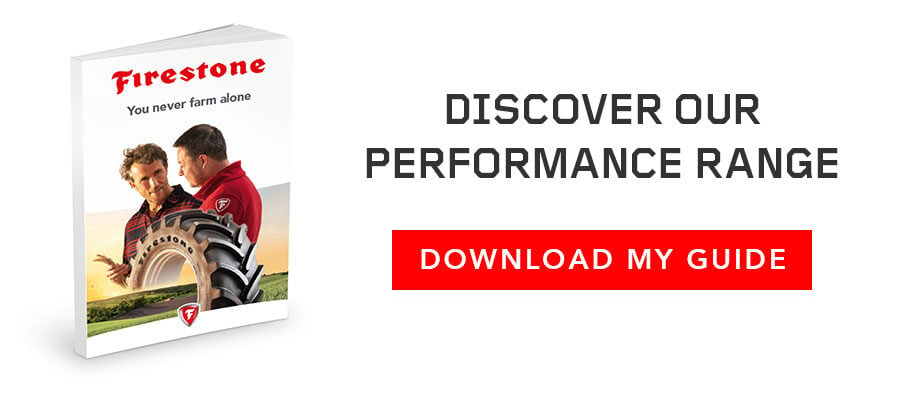Your tractor’s lead ratio allows the front axle to pull slightly more than the rear axle and enables perfect drive axis synchronisation. If your tractor has a good lead ratio, it will be efficient and traction will be optimal.
However, certain settings or the replacement of tyres may lead to this lead ratio being altered, resulting in the appearance of operating irregularities such as increased slip or abnormal wear to your tyres.
In this article we look at the different factors that can cause a change in this setting:
1. What is my agricultural vehicle’s lead ratio?
On a four-wheel drive tractor with different sized tyres, the wheels do not rotate at the same speed. The smaller front wheels will rotate faster.
The tractor manufacturer has taken into account this factor and defined your machine’s drive axle ratio ,which takes account of the exact difference in rolling circumference between front and rear tyres in order to obtain perfect synchronisation.
For your tractor to be efficient in terms of traction, the front axle must pull slightly more when 4WH is engaged. It’s the calculation of this difference which gives the front axle the “pulling” effect that we call lead.
During the life of your tractor, certain settings will be modified, when you change a set of front or rear tyres for example, when your tyres are worn or even when you adapt your inflation pressure, and these different settings may cause your tractor’s lead ratio to change.
2. What impact does wear have on the lead ratio?
The calculation of the lead ratio is directly linked to the rolling circumference of your tyres, so if this changes for any reason, there will be more or less of an impact on the lead ratio.
Wear to your tyre lugs will have a substantial effect on the circumference, because these lugs will lose several centimetres during their lifespan.
As long as your front tyres wear at the same rate as the rear tyres, the settings should stay more or less the same.
But be careful when you replace your rear tyres, or your front tyres, with tyres of the same size, because you will have new tyres with big lugs whereas the lugs on the other axle are worn or much smaller. In this case you must check the lead ratio, because the settings may no longer be adapted and this could lead to operating problems.
3. Is the lead ratio modified by load or inflation pressure?
In the same way as wear, if the load is excessive or the inflation pressure too low in order to protect your soil from compaction, the effective rolling circumference of the tyre will change.
When the load is heavy or when you drive with a low inflation pressure, the loaded radius changes. The tyre effectively flattens out on the ground and the radius between the centre of the axis and the ground decreases. This leads to a new effective rolling circumference which may have an impact on lead.

The effective tyre circumference takes into account the loaded radius
With an acceptable lead ratio being in the range of 0% to 5%, as long as your measurements and settings allow you to remain within this range, you wont encounter any particular problems.
However, if you were close to the limit when your tyres were initially mounted, it is possible that your lead ratio is no longer within the right percentage. It’s always preferable to recalculate the lead ratio taking into account the exact circumference, to ensure that the set of tyres on one axle does not wear too rapidly as a result of incorrect settings.
4. Do not mix technologies when you change tyres
When you change a set of tyres on either the front or the rear axle, make sure that you do not mix technologies, because the deflection capacity is different between a VF technology tyre, for example, and a standard tyre.
In this case, even if you opt for the same size as the original tyres, thinking that this guarantees that you can’t get it wrong, it is highly likely that the deflection of the VF tyre will modify its effective circumference and you will no longer be within the right lead ratio bracket.
In the same way, mixing brands between the front axle and the rear axle can have an impact, even if you keep the same tyre size, since the technology used is not exactly the same between two manufacturers. In this case you will face the same problems as with a change of technology.
What happens if the lead ratio is more than 5%?
If the lead ratio is above 5%, the rear axle will slow down the front axle and your front tyres will wear very rapidly.
What happens if the lead ratio is below 0% (lag)?
If there is lag, the front axle continually slows down the rear axle. The front tyres which are pushed by the rear tyres will wear very fast. All the mechanical power and transmission components (engine, transmission, differentials, reducers… etc.) are placed under too much strain, driving becomes uncomfortable, steering is difficult on heavy ground and the rear axle will have a tendency to slip.
For more information on tractor tyres
With Firestone, you have the guarantee of tractor tyres that deliver a real advantage, and that in choosing our brand, you can work worry-free.

Most people who read this article have also read some of the following articles:
This information is intended only to make you aware of the technical and functional aspects of agricultural tires and their use. It does not allow you to make a judgment or a definitive conclusion on a given problem. Only your agricultural tire expert is able to make a technical assessment and take a final decision, case by case.